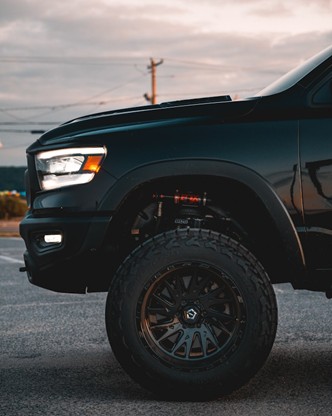Lifted trucks turn heads with their bold presence, off-road prowess, and commanding view of the road – but they also have a reputation for being gas-hungry beasts. Fortunately, it doesn’t have to be that way. A well-built lift kit combined with smart driving habits and a few strategic upgrades, can help you boost fuel efficiency without compromising the power or performance you love.
Whether you’re rolling down the scenic backroads of Georgetown, or navigating the daily grind of stop-and-go traffic in Charleston, the right approach can help you get more miles per gallon while still making the most of your lifted truck’s capabilities.
Why Lifted Trucks Struggle With Fuel Economy
It’s important to understand why lifted trucks typically see a drop in miles per gallon (MPG):
Increased wind resistance: The higher profile of a lifted truck increases aerodynamic drag.
Larger, heavier tires: Bigger tires weigh more and create more rolling resistance.
Altered gear ratios: Changing tire size without adjusting the gear ratio can throw off your engine’s efficiency.
Added weight: Off-road accessories (bumpers, racks, skid plates) add weight, which requires more energy to move.
That said, not all hope is lost. With a few smart upgrades and driving techniques, you can reclaim some of that lost MPG.
Choose the Right Tires and Wheels
Your tire and wheel setup is arguably the biggest contributor to fuel loss on a lifted truck.
How to Optimize
Go for lighter wheels: Forged aluminum wheels are stronger and lighter than steel.
Pick an efficient tire tread: Mud terrains look great but add resistance. Switch to all-terrain or hybrid tires if you don’t need hardcore off-road grip every day.
Size matters: Taller tires can alter your effective gear ratio, so it’s best to choose the smallest size that still delivers the performance you’re looking for.
Keep them inflated: Underinflated tires increase rolling resistance and reduce MPG fast. Check pressure weekly.
Regear Your Differentials
If you’ve upsized your tires but not your gears, your engine is probably working harder than it should.
Why It Matters
Your truck was tuned at the factory for stock tires. Larger tires throw off your RPMs, making your engine run at lower revs than ideal. This causes sluggish performance and poor fuel economy.
What to Do
Regearing your axles to match your tire size (e.g., going from 3.73 to 4.56 gears) brings your power band back into alignment. This helps restore torque and efficiency, especially noticeable when towing or climbing.
It’s an investment, but one of the most impactful mods for restoring fuel economy in a lifted truck.
Get a Custom ECU Tune
Factory engine control units (ECUs) aren’t optimized for larger tires or heavy modifications that can affect your truck’s performance and efficiency. Fortunately, a custom tune can address these issues by adjusting the fuel-to-air mixture and shift points to better suit your specific setup. This results in increased torque and improved throttle response, while optimizing fuel efficiency, especially at cruising speeds. Many truck owners report gaining between 1 to 3 miles per gallon after a professional tune – all without sacrificing power.
Install an Aftermarket Cold Air Intake and Exhaust
Airflow is essential for engine efficiency because when your engine breathes better, it burns fuel more effectively. A cold air intake helps by pulling cooler, denser air into the engine, which improves combustion, enhances throttle response, and can sometimes increase miles per gallon.
Complementing this with a high-flow exhaust system reduces backpressure, making it easier for your engine to expel exhaust gases. Together with a proper tune and cold air intake, these upgrades work synergistically for the best results. While these modifications won’t transform your truck into a fuel-sipping Prius, they will reduce strain on the engine – and give your ride a satisfying growl along the way.
Drive Smarter (Seriously)
One of the most underrated ways to improve gas mileage is simply adjusting your driving habits.
Adopt These Techniques
Avoid jackrabbit starts: Accelerate gradually.
Use cruise control: Maintains a steady speed and reduces unnecessary throttle use.
Coast when possible: Take your foot off the gas when approaching red lights or stop signs.
Limit idling: A big V8 sucks gas just sitting still. Shut it off if you’re waiting more than a minute or two.
Bonus Tip for Local Drivers
In coastal towns, stop-and-go traffic and short trips are MPG killers. Combine errands, use less congested routes, and keep the revs low.
Maintain Your Lifted Truck Like a Pro
Maintenance is even more critical on lifted vehicles. Even minor neglect can drain your MPG.
Checklist for Better Mileage
Change oil regularly: Use synthetic oil for better engine protection and efficiency.
Check air filters: A clogged filter chokes your engine—replace as needed.
Inspect driveline components: U-joints, driveshafts, and CV axles take a beating in lifted trucks. Worn parts = lost energy.
Keep alignment in check: Misalignment increases rolling resistance and tire wear.
Grease suspension components: Reduces friction and improves performance.
Schedule regular inspections – especially if you’re running larger tires or off-roading.

Use Fuel Additives Wisely
Not all fuel additives are gimmicks. Some can clean your injectors, reduce knock, and slightly improve combustion efficiency.
Look For:
- Detergent-based cleaners for injectors and fuel lines.
- Octane boosters if your truck is tuned for premium fuel.
- Lubricating additives for diesel engines.
Use these sparingly and always buy from reputable brands.
Reduce Unnecessary Weight and Drag
That roof rack, tool chest, or massive off-road bumper may look cool – but it adds drag and weight.
Trim the Fat
- Remove gear you don’t use every day.
- Swap steel bumpers for lighter aluminum ones if possible.
- Consider a tonneau cover to streamline airflow over the bed.
- Even 100 extra pounds can cost you 1–2% in fuel economy.
Better Mileage Without Sacrificing the Look or Power
Improving gas mileage in a lifted truck doesn’t mean neutering your build or reverting to stock. It’s about working smarter, not weaker. By optimizing your setup – from tires and gears to tuning and driving style – you can have a powerful, aggressive truck that doesn’t guzzle gas like it’s going out of style.
Whether you’re tearing up trails or rolling through back roads, a little tuning, a little discipline, and a few smart investments go a long way. Lift loud, drive proud and don’t let the gas station win.


